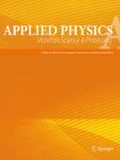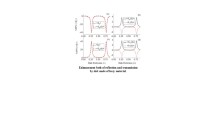Abstract
Over a half-century ago, Balazs proposed a thought experiment to deduce the form of electromagnetic momentum in a lossless and non-dispersive slab by imposing conservation of global momentum and system center-of-mass velocity after a pulse has traveled through the slab. Here, we revisit the Balazs thought experiment by explicit calculations of momentum transfer and center-of-mass displacement of a non-dispersive, positive-index slab of arbitrary complex permittivity and permeability using a set of postulates consisting only of Maxwell’s equations, a generalized Lorentz force law, the Abraham form of the electromagnetic momentum density, and conservation of both pulse and slab mass. In the case where the slab is lossless, we show that a pulse of arbitrary shape incident onto the slab conserves both global momentum and system center-of-mass velocity, consistent with the starting postulates of the Balazs thought experiment. In the case where the slab is lossy, we show, within the context of the above postulates, that global momentum is always conserved and that system center-of-mass velocity is conserved only when mass transfer from the pulse to the slab is described by an incremental pulse-mass-transfer model, proposed here, in which the pulse deposits mass in the slab with a distribution corresponding to the instantaneous mass density profile of the pulse.
Similar content being viewed by others
References
J.C. Maxwell, A Treatise on Electricity and Magnetism, vol. 2 (Dover, New York, 1891)
P. Lebedev, Ann. Phys. 6, 433 (1900)
E.F. Nichols, G.F. Hull, Phys. Rev. 13, 307 (1901)
H. Minkowski, Nachr. Ges. Wiss. Gott., Math.-Phys. Kl. 53, 472 (1908)
M. Abraham, Rend. Circ. Mat. Palermo 28, 1 (1909)
N.L. Balazs, Phys. Rev. 91, 408 (1953)
A. Einstein, Ann. Phys. 20, 627 (1906)
A. Einstein, J. Laub, Ann. Phys. 26, 541 (1908)
M. Mansuripur, Opt. Express 15, 13502 (2007)
M. Mansuripur, Opt. Commun. 284, 594 (2011)
B.A. Kemp, T.M. Grzegorczyk, J.A. Kong, Opt. Express 13, 9280 (2005)
B.A. Kemp, T.M. Grzegorczyk, J.A. Kong, Phys. Rev. Lett. 97, 133902 (2006)
B.A. Kemp, J.A. Kong, T.M. Grzegorczyk, Phys. Rev. A 75, 053810 (2007)
L.D. Landau, E.M. Lifshitz, Electrodynamics of Continuous Media (Pergamon, Elmsdorf, 1960)
Author information
Authors and Affiliations
Corresponding author
Rights and permissions
About this article
Cite this article
Chau, K.J., Lezec, H.J. Revisiting the Balazs thought experiment in the presence of loss: electromagnetic-pulse-induced displacement of a positive-index slab having arbitrary complex permittivity and permeability. Appl. Phys. A 105, 267–281 (2011). https://doi.org/10.1007/s00339-011-6620-9
Received:
Accepted:
Published:
Issue Date:
DOI: https://doi.org/10.1007/s00339-011-6620-9



